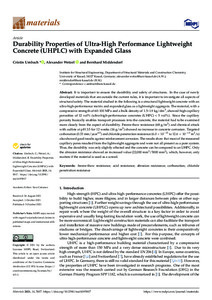| dc.date.accessioned | 2022-01-03T14:45:51Z | |
| dc.date.available | 2022-01-03T14:45:51Z | |
| dc.date.issued | 2021-10-05 | |
| dc.identifier | doi:10.17170/kobra-202112215302 | |
| dc.identifier.uri | http://hdl.handle.net/123456789/13477 | |
| dc.description.sponsorship | Gefördert durch den Publikationsfonds der Universität Kassel | ger |
| dc.language.iso | eng | eng |
| dc.rights | Namensnennung 4.0 International | * |
| dc.rights.uri | http://creativecommons.org/licenses/by/4.0/ | * |
| dc.subject | freeze-thaw resistance | eng |
| dc.subject | acid resistance | eng |
| dc.subject | abrasion resistance | eng |
| dc.subject | carbonation | eng |
| dc.subject | chloride penetration resistance | eng |
| dc.subject.ddc | 620 | |
| dc.title | Durability Properties of Ultra-High Performance Lightweight Concrete (UHPLC) with Expanded Glass | eng |
| dc.type | Aufsatz | |
| dcterms.abstract | It is important to ensure the durability and safety of structures. In the case of newly developed materials that are outside the current rules, it is important to investigate all aspects of structural safety. The material studied in the following is a structural lightweight concrete with an ultra-high-performance matrix and expanded glass as a lightweight aggregate. The material, with a compressive strength of 60–100 MPa and a bulk density of 1.5–1.9 kg/dm³, showed high capillary porosities of 12 vol% (ultra-high-performance concretes (UHPC) < 5 vol%). Since the capillary porosity basically enables transport processes into the concrete, the material had to be examined more closely from the aspect of durability. Freeze-thaw resistance (68 g/m²) and chemical attack with sulfate at pH 3.5 for 12 weeks (16 g/m²) showed no increase in concrete corrosion. Targeted carbonation (0.53 mm/year0.5) and chloride penetration resistance (6.0 × 10−¹³ to 12.6 × 10−¹³ m²/s) also showed good results against reinforcement corrosion. The results show that most of the measured capillary pores resulted from the lightweight aggregate and were not all present as a pore system. Thus, the durability was only slightly affected and the concrete can be compared to an UHPC. Only the abrasion resistance showed an increased value (22,000 mm³/5000 mm²), which, however, only matters if the material is used as a screed. | eng |
| dcterms.accessRights | open access | |
| dcterms.creator | Umbach, Cristin | |
| dcterms.creator | Wetzel, Alexander | |
| dcterms.creator | Middendorf, Bernhard | |
| dc.relation.doi | doi:10.3390/ma14195817 | |
| dc.subject.swd | Dauerhaftigkeit | ger |
| dc.subject.swd | Tragverhalten | ger |
| dc.subject.swd | Frostbeständigkeit | ger |
| dc.subject.swd | Säureschutz | ger |
| dc.subject.swd | Verschleißfestigkeit | ger |
| dc.subject.swd | Carbonation | ger |
| dc.subject.swd | Leichtbeton | ger |
| dc.type.version | publishedVersion | |
| dcterms.source.identifier | eissn:1996-1944 | |
| dcterms.source.issue | Issue 19 | |
| dcterms.source.journal | Materials | eng |
| dcterms.source.volume | Volume 14 | |
| kup.iskup | false | |
| dcterms.source.articlenumber | 5817 | |


